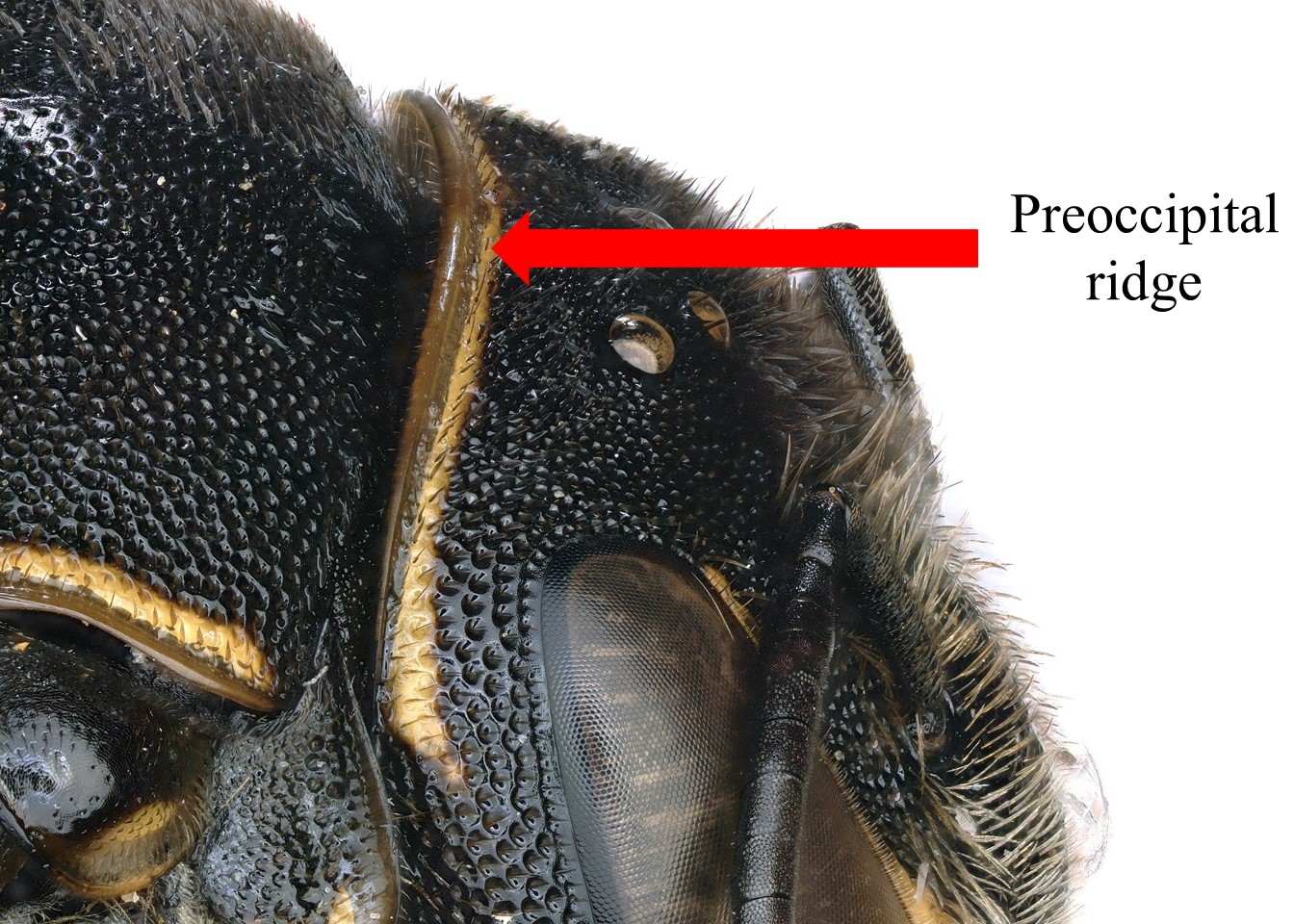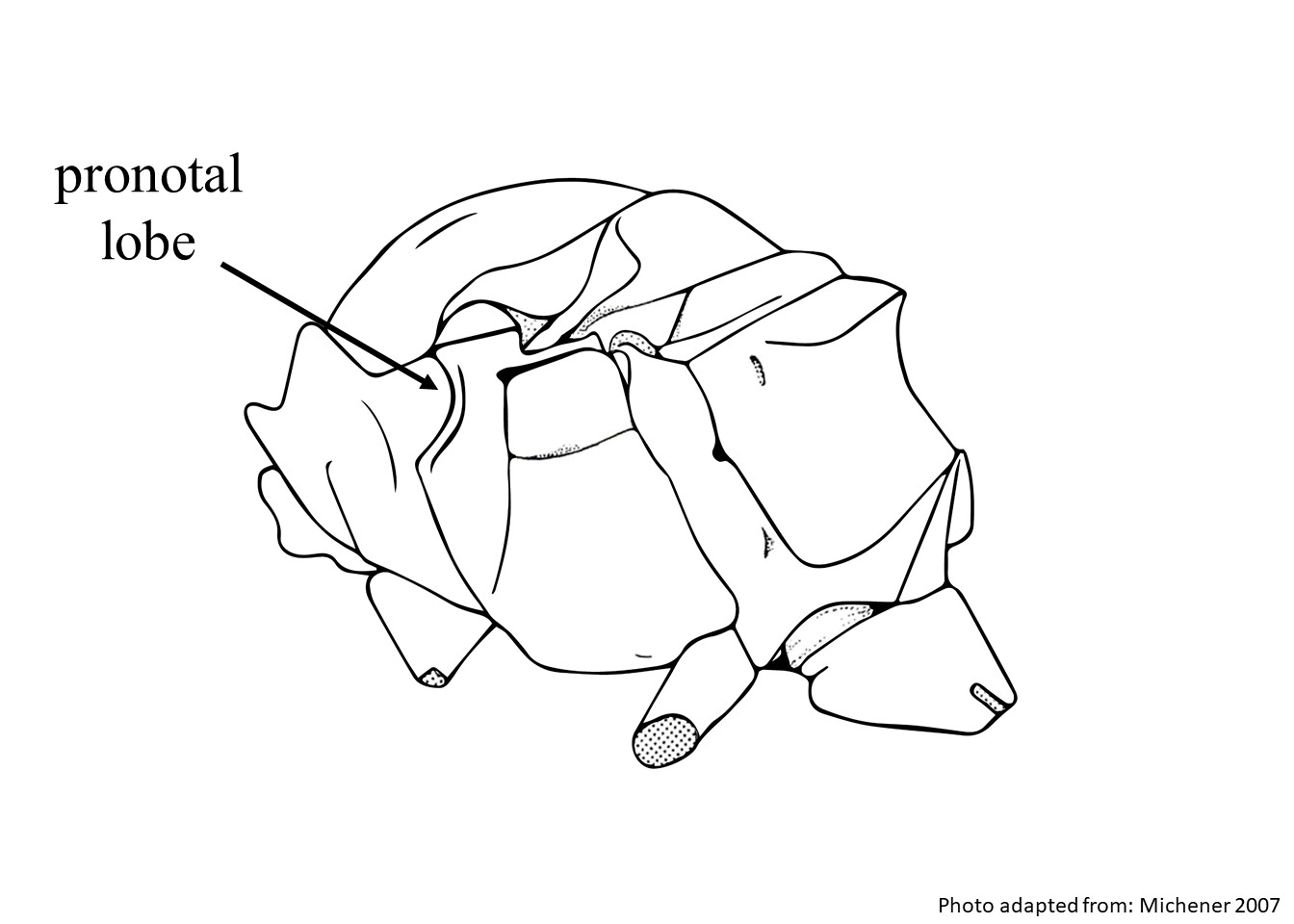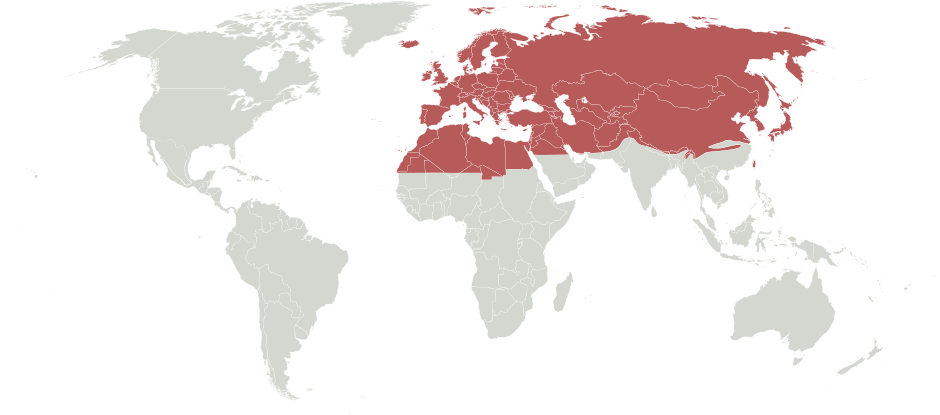Taxonomy
Family: Megachilidae
Subfamily: Megachilinae
Tribe: Anthidiini
Genus: Eoanthidium Popov, 1950
Subgenera: Clistanthidium, Eoanthidium, Hemidiellum, Salemanthidium
Common name: none
Overview
Eoanthidium generally have elongate, slender bodies with black integumentintegument:
a tough, protective outer layer
and yellow maculations (Michener 2007Michener 2007:
Michener, C.D. 2007. The Bees of the World (2nd ed.). Johns Hopkins University Press, Baltimore and London, 953 pp.). Their body length ranges from 6–10 mm.
Diversity
Eoanthidium contains at least 17 species in four subgenera (
Michener 2007Michener 2007:
Michener, C.D. 2007. The Bees of the World (2nd ed.). Johns Hopkins University Press, Baltimore and London, 953 pp.); none are known to occur in the U.S. or Canada.
Diagnostic characteristics
(modified from Michener 2007Michener 2007:
Michener, C.D. 2007. The Bees of the World (2nd ed.). Johns Hopkins University Press, Baltimore and London, 953 pp.)
- Juxtantennal carinacarina:
a clearly defined ridge or keel, not necessarily high or acute; usually appears on bees as simply a raised line
present, although weak in some species.
- Omaulus omaulus:
angle between anterior and lateral surfaces of mesepisternum
 carinatecarinate:
carinatecarinate:
having keels or carinae
or lamellatelamellate:
thin, plate-like, often somewhat translucent structure
.
- Preoccipital ridge preoccipital ridge:
the carina that dorsolaterally surrounds the back of the head
 rounded.
rounded.
- Pronotal lobe pronotal lobe:
a part of the pronotum located dorsally on the posterior margin of the pronotum and overlaps the anterior thoracic spiracle
 strongly carinatecarinate:
strongly carinatecarinate:
having keels or carinae
or weakly lamellatelamellate:
thin, plate-like, often somewhat translucent structure
.
- Propodeum propodeum:
the last segment of the thorax
 with small foveafovea:
with small foveafovea:
a depressed region of cuticle; in bees this depressed area is usually only very slightly hollow and usually on the face.
defined by a carinacarina:
a clearly defined ridge or keel, not necessarily high or acute; usually appears on bees as simply a raised line
behind spiraclespiracle:
a breathing pore, usually occurring on the third thorasic segment
.
- Propodeum propodeum:
the last segment of the thorax
 basalbasal:
basalbasal:
originating at the foundation of a structure
area without a strong row of pits delimited by a posterior carinacarina:
a clearly defined ridge or keel, not necessarily high or acute; usually appears on bees as simply a raised line
.
- Scutellum scutellum:
shield shaped plate behind scutum
 rounded with a small, midapical emarginationemargination:
rounded with a small, midapical emarginationemargination:
a notched or cut out place in an edge or margin, can be dramatic or simply a subtle inward departure from the general curve or line of the margin or structure being described
.
- Scutoscutellar suturesuture:
a groove marking the line of fusion of two distinct plates on the body or face of a bee
forming two distinct foveaefoveae:
a depressed region of cuticle; in bees this depressed area is usually only very slightly hollow and usually on the face.
with a flat, shiny bottom.
- T6 with laterallateral:
relating, pertaining, or attached to the side
teeth present.
- Female S6S6:
the plates on the underside of the abdomen, often abbreviated when referring to a specific segment to S1, S2, S3, S4, S5, S6, S7, or S8
 either with median spine or preapicalpreapical:
either with median spine or preapicalpreapical:
referring to a section of a bee that is physically found just before the outermost (or apical) end of the section or segment
carinacarina:
a clearly defined ridge or keel, not necessarily high or acute; usually appears on bees as simply a raised line
.
- Male sternasterna:
the plates on the underside of the abdomen, often abbreviated when referring to a specific segment to S1, S2, S3, S4, S5, S6, S7, or S8
 with marginal combs absent.
with marginal combs absent.
- Male gonostylusgonostylus:
the apical-most appendage of the male genitalia, which is usually quite hairy
is flattened distally, and generally has a median bend.
- Male penis valves large and apicallyapically:
near or at the apex or end of any structure
pointed.
May be confused with
Eoanthidium can be confused with Acedanthidium due to their similar size and foveate scutoscutellar suturesuture:
a groove marking the line of fusion of two distinct plates on the body or face of a bee
. However, Eoanthidium can be differentiated from the Acedanthidium by the presence of juxtantennal carinae in Eoanthidium (Michener 2007Michener 2007:
Michener, C.D. 2007. The Bees of the World (2nd ed.). Johns Hopkins University Press, Baltimore and London, 953 pp.).
Known invasives
There are no known invasives.
Host associations
Eoanthidium are generalists and forage on a broad variety of plants (Müller 1996). Eoanthidium punjabensis has been observed visiting Prosopis cineraria (Fabaceae) (Gorain et al. 2012Gorain et al. 2012:
Gorain, M., S.K. Charan, and S.I. Ahmed. 2012. Role of insect bees in the pollination of Prosopis cineraria (L.) Druce (Leguminosae, Subfamily Mimosoideae) in Rajasthan. Advances in Applied Science Research 3: 3448ndash;3451.).
Nesting behavior
Nesting behavior is unknown.
Distribution
Eoanthidium occurs in the eastern Mediterranean, southwestern Asia, southern Russia, southern India, Pakistan, and Africa (Michener 2007Michener 2007:
Michener, C.D. 2007. The Bees of the World (2nd ed.). Johns Hopkins University Press, Baltimore and London, 953 pp.).

Distribution map generated by Discover Life -- click on map for details, credits, and terms of use.
References
Gorain, M., S.K. Charan, and S.I. Ahmed. 2012. Role of insect bees in the pollination of Prosopis cineraria (L.) Druce (Leguminosae, Subfamily Mimosoideae) in Rajasthan. Advances in Applied Science Research 3: 3448-3451.
Michener, C.D. 2007. The Bees of the World. 2nd ed. Johns Hopkins University Press, Baltimore and London, 953 pp.
Müller, A. 1996. Host plant specialization in western PalearcticPalearctic:
the largest biogeographic region; consists of Europe, Asia north of the Himalaya foothills, Northern Africa, and the northern and central parts of the Arabian Peninsula
 anthidiine bees. Ecological Monographs 66: 235-257.
anthidiine bees. Ecological Monographs 66: 235-257.
 carinatecarinate:
carinatecarinate: rounded.
rounded. either with median spine or preapicalpreapical:
either with median spine or preapicalpreapical: with marginal combs absent.
with marginal combs absent. anthidiine bees. Ecological Monographs 66: 235-257.
anthidiine bees. Ecological Monographs 66: 235-257.